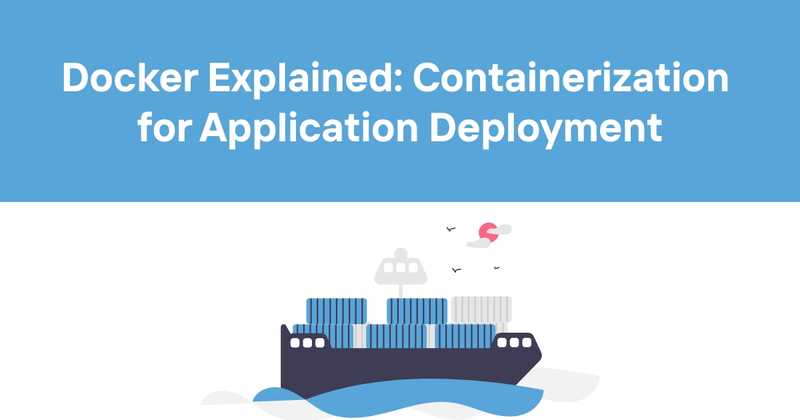Docker Explained: Containerization for Application Deployment
Docker has completely changed the way we think about application deployment. When I first encountered Docker, it struck me as an elegant solution to a problem that had plagued developers for years: "Why does my code work on my machine but break on the server?" This frustrating experience was so common that "works on my machine" became a running joke in software development circles.
In this article, I'll explore what Docker is, how it works, and why it has become such a critical tool in modern software development. I'll also cover practical aspects of working with Docker and address common questions developers have.
Table of contents
- Introduction to Docker
- Core concepts of Docker
- Docker architecture
- Key components of Docker
- Docker vs. virtual machines
- Setting up Docker
- Working with Docker containers
- Docker images
- Dockerfile explained
- Docker Hub and registries
- Docker Compose
- Docker networking
- Docker volumes
- Docker in production
- Docker and Kubernetes
- Common Docker commands
- Docker best practices
- Monitoring Docker containers
- Conclusion
Introduction to Docker
Docker is an open-source platform that enables developers to build, package, and run applications in containers. These containers bundle an application with all its dependencies—libraries, configuration files, binaries—into a standardized unit that can run consistently across different computing environments.
The beauty of Docker lies in its ability to solve the "it works on my machine" problem. With Docker, when you develop an application, you package it with everything it needs to run. Then you can deploy that exact package on any machine that has Docker installed, with confidence that it will work just as it did in your development environment.
Docker was first released in 2013 by Docker, Inc. (originally called dotCloud), and it quickly gained popularity due to its ability to simplify deployment and increase development efficiency. Today, it's a fundamental tool in DevOps practices, cloud-native application development, and microservices architectures.
Core concepts of Docker
To understand Docker, you need to grasp three core concepts:
Containers
Containers are lightweight, portable, and self-sufficient units that can run applications. Think of a container as a mini-computer within your computer, with its own isolated environment. Containers share the host system's OS kernel but run as isolated processes.
When you run a container, it starts from an image and becomes a running instance of that image. Multiple containers can run on the same machine, each isolated from the others.
Images
Docker images are read-only templates used to create containers. An image includes everything needed to run an application—the code, runtime, libraries, environment variables, and configuration files.
Images are built in layers, with each layer representing a change to the filesystem. This layered approach makes images lightweight and easy to share.
Dockerfile
A Dockerfile is a text file containing instructions for building a Docker image. Each instruction in a Dockerfile creates a layer in the image. Dockerfiles start with a base image and add additional layers through various commands like RUN, COPY, and ENV.
Docker architecture
Docker uses a client-server architecture:
- Docker client: The command-line interface (CLI) that allows users to interact with Docker.
- Docker daemon (dockerd): The background service that manages Docker objects such as images, containers, networks, and volumes.
- Docker registry: A storage repository for Docker images. Docker Hub is the default public registry, but you can also set up private registries.
When you run a Docker command, the client sends it to the daemon, which carries out the command. If the command involves an image that isn't available locally, the daemon pulls it from a registry.
Key components of Docker
Docker has several key components that work together:
Docker Engine
Docker Engine is the core of Docker. It includes:
- The Docker daemon (dockerd)
- A REST API for interacting with the daemon
- A command-line interface (CLI) client
Docker Desktop
Docker Desktop is an application for Windows and macOS that includes Docker Engine, Docker CLI, Docker Compose, and other tools to make using Docker easier on these operating systems.
Docker Hub
Docker Hub is a cloud-based registry service where you can find and share container images. It's like GitHub for Docker images.
Docker Compose
Docker Compose is a tool for defining and running multi-container Docker applications. With Compose, you use a YAML file to configure your application's services, and then start all services with a single command.
Docker Swarm
Docker Swarm is Docker's native clustering and orchestration solution. It turns a group of Docker engines into a single virtual Docker engine, allowing you to deploy and manage applications across multiple hosts.
Docker vs. virtual machines
Both Docker containers and virtual machines (VMs) provide isolation, but they do it differently:
| Feature | Docker Containers | Virtual Machines |
|---|---|---|
| Size | Lightweight (MBs) | Heavy (GBs) |
| Boot time | Seconds | Minutes |
| Operating system | Shares host OS kernel | Needs full OS |
| Performance | Near-native | Overhead due to hypervisor |
| Isolation | Process-level isolation | Complete isolation |
| Resource usage | Efficient | More resource-intensive |
The key difference is that containers share the host system's kernel, while VMs include a full copy of an operating system. This makes containers more lightweight and faster to start.
Let me give you a practical example. On my development machine, I can run dozens of Docker containers simultaneously without significant performance impact. The same number of VMs would bring my system to a crawl. This efficiency is why Docker is so popular for microservices architectures, where you might need to run many services at once.
Setting up Docker
Setting up Docker is straightforward on most platforms:
Linux
On Linux, you can install Docker directly:
sudo apt-get update
# Install dependencies
sudo apt-get install <br>
apt-transport-https </span>
ca-certificates </span>
curl </span>
gnupg </span>
lsb-release
# Add Docker's official GPG key
curl -fsSL https://download.docker.com /linux/ubuntu/gpg | sudo gpg --dearmor -o /usr/share/ keyrings/docker-archive-keyring.gpg
# Set up the stable repository
echo <br>
"deb [arch=amd64 signed-by=/usr/share/ keyrings/docker-archive-keyring.gpg] https://download.docker.com/ linux/ubuntu </span>
$(lsb_release -cs) stable" | sudo tee /etc/apt/sources. list.d/docker.list > /dev/null
# Install Docker Engine
sudo apt-get update
sudo apt-get install docker-ce docker-ce-cli containerd.io
Windows and macOS
For Windows and macOS, you can download Docker Desktop from the Docker website. This provides a GUI for managing Docker and includes all the tools you need.
After installation, verify that Docker is working by running:
# Run a test container
docker run hello-world
The hello-world container is a simple test to confirm that Docker is set up correctly.
Working with Docker containers
Let's explore some basic Docker container operations:
Running a container
To run a container, use the docker run command:
This command pulls the nginx image from Docker Hub and runs it. The container continues running until you stop it.
Managing containers
Here are some commands for managing containers:
- List running containers:
docker ps
- List all containers:
docker ps -a
- Stop a container:
docker stop container_id
- Remove a container:
docker rm container_id
- Execute a command in a running container:
docker exec -it container_id command
Container lifecycle
A Docker container goes through several states:
- Created: The container has been created but not started
- Running: The container is running
- Paused: The container's processes have been paused
- Stopped: The container's processes have been stopped
- Deleted: The container has been removed
You can check a container's state with docker inspect container_id.
Docker images
Docker images are the foundation of containers. Let's look at how to work with them:
Pulling images
To download an image from a registry, use:
If you don't specify a tag, Docker uses the latest tag by default.
Listing images
To see the images you have locally:
docker images
Removing images
To remove an image:
Building images
To build an image from a Dockerfile:
The . specifies that the Dockerfile is in the current directory.
Dockerfile explained
A Dockerfile contains instructions for building an image. Here's a simple example:
WORKDIR /app
COPY package*.json ./
RUN npm install
COPY . .
EXPOSE 3000
CMD ["npm", "start"]
Let's break down each instruction:
FROM: Specifies the base image
WORKDIR: Sets the working directory inside the container
COPY: Copies files from the host to the container
RUN: Executes commands during the build
EXPOSE: Informs Docker that the container listens on the specified port
CMD: Provides the default command to run when the container starts
Each instruction creates a new layer in the image. Layers are cached, so if you rebuild an image and only certain layers have changed, Docker reuses the unchanged layers, making builds faster.
Docker Hub and registries
Docker Hub is the default public registry for Docker images. It contains thousands of pre-built images that you can use as the basis for your own containers.
Pushing images to Docker Hub
To share an image on Docker Hub:
- Tag the image with your Docker Hub username:
- Push the image:
Private registries
For sensitive applications, you might want to use a private registry. Docker supports several options:
- Docker Hub paid plans include private repositories
- Docker Registry is an open-source registry you can host yourself
- Cloud providers offer container registries (AWS ECR, Google Container Registry, Azure Container Registry)
Docker Compose
Docker Compose simplifies working with multi-container applications. With Compose, you define your application's services, networks, and volumes in a YAML file.
docker-compose.yml
Here's a simple docker-compose.yml file for a web application with a database:
services:
web:
build: .
ports:
- "5000:5000"
depends_on:
- db
db:
image: postgres
environment:
POSTGRES_PASSWORD: example
volumes:
- db-data:/var/ lib/postgresql/data
volumes:
db-data:
This defines two services (web and db), connects them, and sets up a persistent volume for the database.
Basic Compose commands
- Start services:
docker-compose up
- Start services in background:
docker-compose up -d
- Stop services:
docker-compose down
- View logs:
docker-compose logs
- Rebuild services:
docker-compose build
Docker networking
Docker provides several network drivers:
- bridge: The default network driver. Containers on the same bridge network can communicate with each other.
- host: For standalone containers, removes network isolation between the container and the host.
- overlay: Connects multiple Docker daemons and enables Swarm services to communicate with each other.
- macvlan: Assigns a MAC address to a container, making it appear as a physical device on your network.
- none: Disables all networking for a container.
Creating networks
You can create custom networks with:
Then connect containers to it:
Network communication
Containers on the same network can communicate using their service names as hostnames. For example, in the previous Compose example, the web service could connect to the database using db as the hostname.
Docker volumes
Docker volumes provide persistent storage for containers. When a container is removed, its data is lost unless it was stored in a volume.
Types of volumes
- Named volumes: Created and managed by Docker
- Host volumes: Maps a directory on the host to a directory in the container
- Anonymous volumes: Created by Docker but not given a specific name
Working with volumes
Here are some common volume commands:
- Create a volume:
docker volume create my_volume
- List volumes:
docker volume ls
- Inspect a volume:
docker volume inspect my_volume
- Remove a volume:
docker volume rm my_volume
Using volumes with containers
To use a volume with a container:
Or with Compose:
web:
image: my_image
volumes:
- my_volume:/path/in/ container
volumes:
my_volume:
Docker in production
Using Docker in production requires careful planning:
Security considerations
- Scan images for vulnerabilities
- Use minimal base images
- Run containers with least privilege
- Keep Docker and dependencies updated
- Use read-only filesystems when possible
Container orchestration
For production deployments, especially with many containers, an orchestration platform helps manage the containers. Options include:
- Kubernetes
- Docker Swarm
- Amazon ECS
- Google Kubernetes Engine (GKE)
- Azure Kubernetes Service (AKS)
Monitoring
Monitoring containers is essential for detecting issues. Tools like Prometheus, Grafana, Datadog, and New Relic provide insights into container health and performance.
Docker and Kubernetes
Kubernetes has become the dominant container orchestration platform. While Docker is great for running containers on a single host, Kubernetes excels at managing containers across multiple hosts.
Kubernetes provides:
- Automatic scaling: Adds or removes containers based on load
- Service discovery: Makes it easy for services to find and communicate with each other
- Load balancing: Distributes traffic across containers
- Self-healing: Restarts containers that fail or replaces nodes that die
- Rolling updates: Updates services without downtime
Docker integrates with Kubernetes through the Container Runtime Interface (CRI). Most major cloud providers offer managed Kubernetes services.
Common Docker commands
Here's a reference of common Docker commands:
Container commands
docker run: Create and start a container
docker start: Start a stopped container
docker stop: Stop a running container
docker restart: Restart a container
docker pause: Pause a running container
docker unpause: Unpause a paused container
docker rm: Remove a container
docker ps: List running containers
docker ps -a: List all containers
docker logs: View container logs
docker exec: Run a command in a running container
docker inspect: View detailed information about a container
Image commands
docker build: Build an image from a Dockerfile
docker pull: Pull an image from a registry
docker push: Push an image to a registry
docker images: List images
docker rmi: Remove an image
docker history: Show the history of an image
docker tag: Tag an image
docker save: Save an image to a tar archive
docker load: Load an image from a tar archive
Docker best practices
To get the most out of Docker, follow these best practices:
Image optimization
- Use specific image tags, not
latest
- Use multi-stage builds to reduce image size
- Order Dockerfile instructions from least to most frequently changing
- Use
.dockerignoreto exclude unnecessary files
- Minimize the number of layers
- Group related commands to reduce layers
Container management
- Use meaningful container names
- Set resource limits
- Clean up unused containers and images
- Use health checks
- Implement proper logging
- Don't store sensitive data in images
Example of a multi-stage build
Multi-stage builds create smaller, more secure images by separating build and runtime environments:
FROM node:14 AS build
WORKDIR /app
COPY package*.json ./
RUN npm install
COPY . .
RUN npm run build
# Production stage
FROM nginx:alpine
COPY --from=build /app/build /usr/share/nginx/html
EXPOSE 80
CMD ["nginx", "-g", "daemon off;"]
This builds the application in one stage and copies only the built assets to the final image, resulting in a much smaller image.
Monitoring Docker containers
Monitoring is crucial for maintaining healthy Docker environments. Here are some key metrics to monitor:
- CPU usage: Identifies containers using excessive CPU
- Memory usage: Detects memory leaks or insufficient allocation
- Disk I/O: Shows containers with high disk activity
- Network I/O: Identifies network bottlenecks
- Container health: Checks if containers are running properly
Tools for monitoring Docker include:
- Docker stats: Provides basic real-time metrics
- cAdvisor: Collects, aggregates, and exports container metrics
- Prometheus: Monitoring and alerting toolkit
- Grafana: Visualization platform for metrics
- Datadog: Comprehensive monitoring solution
A simple monitoring command is:
This shows real-time usage statistics for running containers.
Conclusion
Docker has revolutionized application development and deployment by making it easy to package applications with all their dependencies. By using containers, developers can build applications that run consistently across different environments, from development to production.
Key benefits of Docker include:
- Consistency: Applications run the same way everywhere
- Isolation: Containers don't interfere with each other
- Efficiency: Containers share the host OS kernel, making them lightweight
- Portability: Containers can run on any system with Docker installed
- Scalability: Containers can be easily scaled up or down
Docker continues to evolve, with improvements in security, performance, and integration with other tools. Whether you're developing a small personal project or managing a large-scale production environment, Docker provides valuable tools for simplifying deployment and managing applications.
For robust uptime monitoring of your Docker containers and services, consider using Odown. Odown helps you monitor your containerized applications, detect issues before they affect users, and maintain reliable services. It also offers SSL certificate monitoring to ensure your containers' secure connections remain valid, and public status pages to keep your users informed about your services' status.
Starting with Docker might seem challenging, but the benefits it brings to development workflows make it well worth the effort. By understanding the core concepts and following best practices, you can leverage Docker to build, ship, and run applications more efficiently than ever before.



